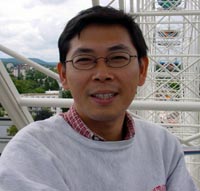10th IAPR International Workshop on Document Analysis Systems
March 27th - 29th, 2012
Gold Coast, Queensland, Australia
Tutorials
We have two tutorials in DAS 2012 from distinguished speakers. The details about the tutorials are given below. The tutorials are free of charge. Interested participants are requested to register to attend the tutorial by sending an email to das2012@griffith.edu.au.
Tutorial 1
(March 26th, 2012, 9.00am - 12.40pm)
 |
Speaker :Dr. Gernot A. FinkTU Dortmund, Department of Computer ScienceDortmund, Germany |
|---|
Title: Markov Models for Handwriting Recognition
 Slides
Slides
Abstract:
Handwriting recognition today is an important component of many systems in the field of document analysis and recognition. Therefore, researchers and practitioners are routinely faced with the problem of using handwriting recognition technology, either by applying it within the framework of a larger document analysis system or by developing methods for reading handwritten texts.
With the introduction of the statistical paradigm to the field of automatic handwriting recognition it became possible to build extremely successful recognizers based on the concept of Markovian models that offer two important advantages over competing approaches: First, the parameters of the complex recognition models can largely be estimated automatically from sample data.
Second, the resulting models implicitly solve the problem of segmentation and classification in an integrated manner. Therefore, the majority of handwriting recognition systems today is based on this technology (Ploetz & Fink 2010).
Recognition systems based on Markov models use two distinct modelling components. The appearance of the handwriting is described by hidden Markov models (HMMs), which constitute the so-called writing model. The second modelling component describes long term sequencing restrictions within the data, i.e., on the level of word or character sequences. This so-called language model is usually realized by Markov chain models. In combination, the writing and the language model form a powerful statistical description of handwriting. The parameters of the models can be estimated automatically on sample data. The so-called decoding of the integrated model - i.e., the search for the optimal path through the combined state space - provides the optimal segmentation and classification of the data in an integrated framework.
In this tutorial the mathematical foundations of Markov models as well as the important concepts, methods, and algorithms necessary to build successful handwriting recognition systems in practice will be presented. The tutorial is targeted at people basically familiar with statistical pattern recognition methods who want to deepen their knowledge in order to be able to build real handwriting recognition systems. The tutorial will be organized in two parts.
In the first part the necessary conceptual background will be introduced including the architecture of a state-of-the-art statistical handwriting recognition system. The second part will focus on the practical application of the methods presented including examples on how the respective funcionality can be achieved using the open-source development environment ESMRALDA
(Fink & Ploetz 2008; http://sourceforge.net/projects/esmeralda).
For participants of the tutorial willing to delve deeper into the subject a worked out example of the development of a handwriting recognition system for a small offline recognition task will be available as accompanying material.
Recommended Reading
- Fink 2008: Markov Models for Pattern Recognition, From Theory to Applications. Springer, 2008.
- Fink & Ploetz 2008: Developing pattern recognition systems based on Markov models: The ESMERALDA framework. Pattern Recognition and Image Analysis, 18(2):207-215, 2008.
- Ploetz & Fink 2009: Markov Models for Offline Handwriting Recognition: A Survey.
Int. Journal on Document Analysis and Recognition,
12(4):269-298, 2009.
(available as Open Access document from Springer:
http://www.springerlink.com/content/l6056u2x0686n0l8/)
- Ploetz & Fink 2011: Markov Models for Handwriting Recognition. SpringerBriefs in Computer Science, Springer, 2011.
(available online from www.springerlink.com)
Tutorial 2
(March 26th, 2012, 1.40pm - 5.10pm)
 |
Speaker : Dr. Koichi KiseIntelligent Media Processing GroupDepartment of Computer Science and Intelligent Systems, Graduate School of Engineering, Osaka Prefecture University, Japan. |
|---|


